• AN EXHAUSTIVE STUDY: Here I present Part II of a series of a comprehensive sub-genre analysis features that began back in 2015 (Technical Thrash Metal, Melodic Hardcore/Skatepunk) on another site. This second pass for Melodic Black Metal will be a more comprehensive redux of the series which began back in 2017 and generally completed in 2018 wherein seven enormous entries detailed key releases from 1991-2005. It is necessary to rewrite, ‘remaster’ and approach this subject another time due to the old columns no longer linking to their album artwork, most of them weren’t very thoughtfully written, and the type of posts used were not created for mobile readership rendering them impossible to read. This will not be a plain recreation of that list but rather a more complete, far more in-depth format which makes less of an effort to draw the line between sub-genres and instead aims to better understand the delineation between melodic black metal and the general evolutionary origin of the sub-genre next to many others.
The method for this type of feature is simple: I procure a chronological list of demos, EPs, splits and full-lengths from various sources. I then re-listen to every release in order, research each band, and report my thoughts and observations including trivia and relevance. This time around I will include ~6-10 items per entry and each one will (eventually) include a short video. Instead of deciding if these releases truly resemble the sub-genre suggested per available public databases (Metal Archives, Discogs, Rateyourmusic, etc.) I will further make the argument for what releases I believe are in keeping with the canonical highest standard, influential or important items for the melodic black metal form. This should allow some understanding of this musical style and the need for distinction between subculture movements in underground music and the incessant waves of imitation beyond the original thought. — This first entry will consider the sub-genre in its most naive and unformed state and will call for at least some general narration of the various black metal scenes, styles, and trains of thought which lead to certain bands being labeled “melodic” then and in hindsight. Level headed, respectful feedback is welcomed by way of grizzlybutts@hotmail.com
If you missed Part I, which covered 1990-1991, catch up here:
An Exhaustive Study: Melodic Black Metal Redux [Pt. I] – ‘Accessing the Unsacred Nocturn Beyond’
MCMXCII – Quietus’ Horizon
Anno 1992 CE finally delivered upon the great threat(s) of the north wherein Norwegian bands Darkthrone, Immortal, and Emperor (all previously involved in death metal) made their grand entrances in some sense. Of course we cannot avoid mention of Burzum though their work was clearly evolving beyond death and thrash metal limitations their story is best reserved for discussion of atmospheric values, the efficiencies of black metal riffcraft at a most basal level, and such… but these are things you should go into this exploration already having vague understanding of. Just as important is the additional context of the global black metal scene wherein Master’s Hammer, Belial (Finland), Samael, Mystifier, and Impaled Nazarene further expanded the black/death metal paradigm and shared/copacetic features. Let’s also not sidestep esoteric contributions from USBM, such as Acheron and Von, as well as the ever-outlier Root (Czechia) and ‘The Temple in the Underworld‘ where we find their exaggerations of the “first wave” still bleeding in the midst of the second. We could dig much deeper into the world of demo tapes at the time, and we essentially will throughout 1992 and even more in 1993, but for now I’d suggest that you tune your perspective toward the understanding that death metal was about to crest upon its biggest wave of notice whereas black metal was viewed as the “next” thing emergent and in the case of some folks their own teenaged counter-cultural vision of independence, a spiritual creature no one would dare “steal” and commodify away from the underground.
The one outlier I would introduce here but not include in full examination is Switzerland’s Alastis, by most accounts a Samael-related (members of both bands played in excellent death/doom metal band Misery in the early 90’s) and black/doom styled band to start before becoming a “dark metal” (read: gothic) group whenever that style became popular. Their slow, often morose and trudging form excuses itself from talk of outright melodicism in the traditional sense but as we reach for their rare debut LP (‘The Just Law‘, 1992) , the first release from Slayer Mag editor Metalion’s Head Not Found label, it is at least worth mentioning as a sign of the many different currents and points of inspiration feeding into black metal at the time. If you’d like to dig deeper in that direction I’d offer mention of Salem (Israel) up ’til ‘Kaddish‘ at most, Argentum (Mexico), and of course the oddball Sadness, also from Switzerland, among many others. Of course this means Katatonia‘s first tape is also in question… giving us a similar example of black metal intent, an original sound, and no further avenue to explore beyond a side note.
NOTE: Brazilian black metal fans, we are missing any archives for Lord Blasphemate‘s earliest cassette tape demo ‘Nocturnal Black Goat‘. While I am sure that it is terrible in quality, a live rehearsal tape recorded on the docks, this would be an interesting portal to discover this band who seem to have shared some inspiration with bands like Mystifier, such as early Hellenic black metal. Otherwise we will see them in 1993 for an hourlong tape which even manages to cover “The Old Coffin Spirit.”
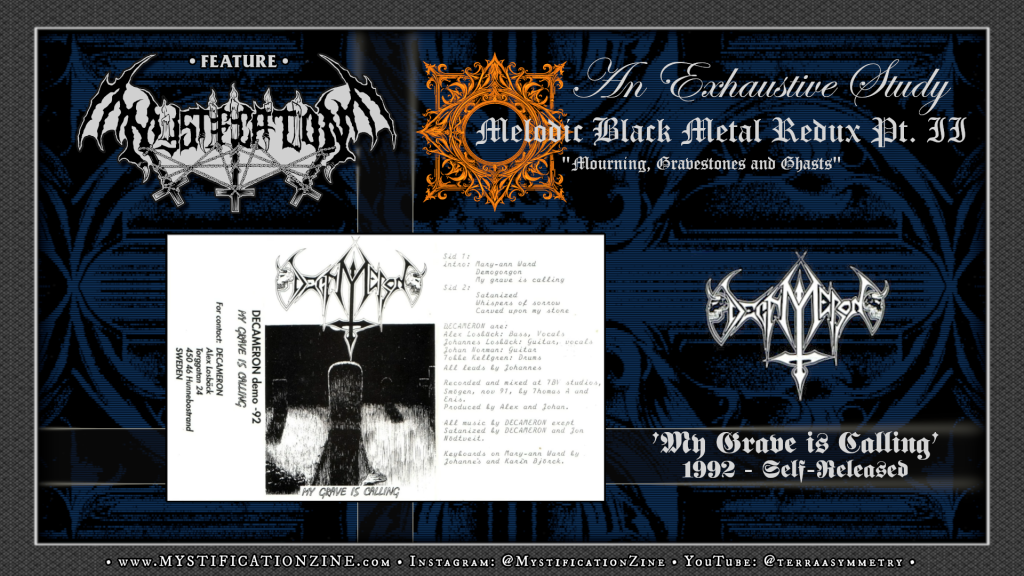
We begin with a demo tape recorded in late 1991 by way of young folks from small northern harbor towns in Västra Götaland (Kungshamn and Hunnebostrand) who’d decided to leave behind their ’88-’91 ways as a Satanic death metal band named Nocrofobic and make the transition to what most would agree is essentially Swedish black/death metal of its time (see: Grotesque, Unanimated) which seems to bear some of the knack developed by Eucharist and Dissection on nearby recordings in terms of their dual guitar arrangements and very strong transitional movement that must’ve been inspired by both Deicide (“Whispers of Sorrow”) and King Diamond on some level. It is unfortunate that Decameron never had much of a spokesperson pushing their own legacy as we find many sophists taking quick trips through the No Fashion discography and assuming their work was an also-ran when in fact their own take on things was always musically accomplished and unlike their peers by the time their debut released. We will get more into that fate later (we’ll have to blame No Fashion naive business practices, basically) but I’d suggest the listener approach Decameron‘s first demo tape with an open mind, especially if you are a student of the most elite and punishing side of early Swedish death metal and appreciate the first At the Gates and Necrophobic records.
While we won’t be able to compare the general output of this tape to ‘Into Infinite Obscurity‘ we can point to one song, wherein a fairly famous piece (“Satanized”) was co-written with Jon Nödtveidt. This tape also begins to unlock discussions on more than Dissection, including the signature drum work of Tobias Kellgren who would also feature in related groups Swordmaster, Soulreaper, and (nowadays) Sacramentum.
More Info:
YouTube: https://www.youtube.com/watch?v=xZJIH8-ghQw [Tell Ken to please NOT delete his channel!]

Though Linköping-borne group Dawn appear later in the (still early) conversation on melodic black metal they are undoubtedly contemporaries and a key name in melodic black metal history as Fredrik Söderberg‘s venture under this name began as a solo act several years before others had gotten their start per a history which traces back to roughly 1986 but strikes upon its death metal origin circa ~1990. The incredible thing about this very short and simply applied demo tape isn’t its sophistication or the romanticist gnarls that’d become part of their spiritual incline later on but rather that it so righteously gets the brazen brutality of death metal right in quick and decisive swipes of maniac riffs. The solos aren’t interesting as much as the atmosphere of the recording is, comparable to that of Molested (Norway) in terms of heavy and storming movement which is violent and voluminous in its birth. Of course they had another tape on the way that same year and that’d be more of a definitive statement into the black metal realm, for now I’d present this tape as a point of contrast as to where their evolution was at one point and then the “leap” we found the band take into the future a few months later.
More Info:
Bandcamp: https://centurymedia.bandcamp.com/album/the-eternal-forest-demo-years-91-93
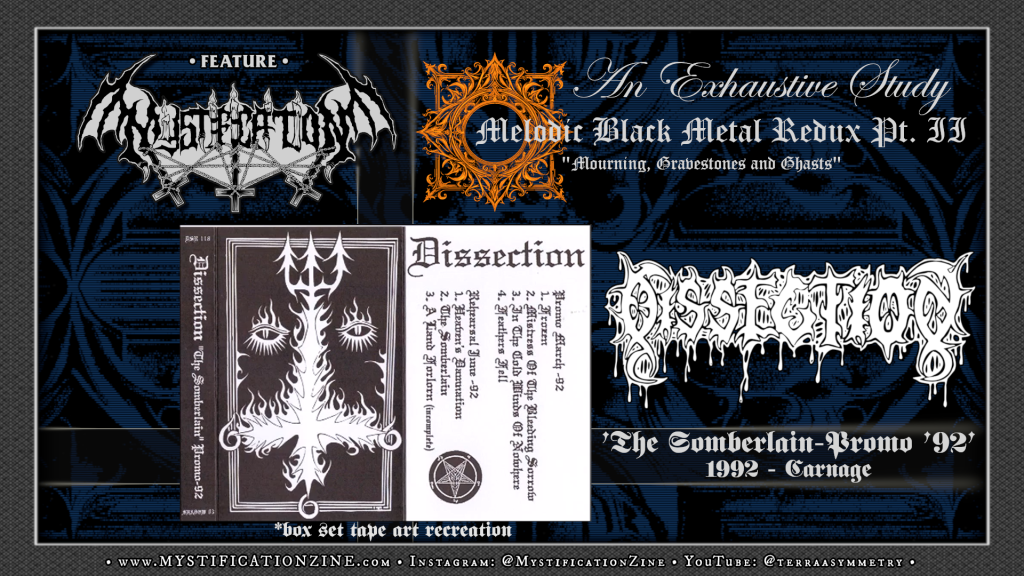
Now that we’ve gotten a good idea of what everyone else was doing in black metal, in Swedish death metal, and in development of the melodic death metal style we find the perfect and most brilliant combination of these things within a set of four inspired and quite original songs. Rather than copy the dancing shapes of Eucharist‘s dual guitar attack (which wasn’t as ready, yet) the arrangements here create concerted lyrical phrases, highly tuneful movement which is both sinister and sophisticated in its yet to be perfected voice here on these tapes. We find the punishing whip of death metal still drives the menacing pace of songs like “In the Cold Winds of Nowhere” but not in the coldly chromatic force which the precursor-feeling wounds cut by Decameron‘s first tape seem to display. We also get a sense of the coming dramatism and atmosphere developed not only but their haunting dual guitar creations but the acoustic interlude and spoken word piece which ends the original tape. Now, we should still give a song like “Greeting Immortality” most of the credit for this romanticist, almost gothic feeling of austerity and dread but here that core idea is laid on thick, elaborated into a voice which was now confidently stretching the possibilities with some consistency song after song. I won’t delve too much into the rehearsal pieces here beyond noting that they grant the keen-earned listener a very clear window in to the ambitions of ‘The Somberlain‘ (1993) debut LP. I’ll save any further thoughts on Dissection once we reach that first full-length.
For additional context, when these songs were being perfected beyond the late ’91 release of ‘Into Infinite Obscurity‘ At the Gates were recording ‘The Red in the Sky is Ours‘ which saw release in November 1992, a full year after its recording. I won’t skate past the genius of Svensson and crew in this exploration, but rather hold onto it for now beyond an adjunct note wherein it is commonly stated that Dissection had a shared (or, adjacent) rehearsal space to that of the band in Gothenburg and was witness to their developing work and vice versa. Again, this was rarely viewed as a competitive space until a few bands quickly became successful later on; The main point to make is that for many that first album from At the Gates was both a last word on the arms race for Swedish death metal of a certain caliber fermenting since the late 80’s and a new high standard for anyone paying attention. This is where we find the artistic breakthroughs from folks doing something different, innovating at a highest-speed race toward “album ready” results. For additional context I always consider Darkthrone‘s ‘Soulside Journey‘ at this point, having been recorded in Sweden in late 1990, and apply the thought that for people intently connected to their fandom there was a new, hungrier idea developing in every available rehearsal space. I don’t think I’d blame them for dropping the next-level technical demands and refinement needed to press on into 1992-era death metal with that sound, though I’d have been happy with the intent of ‘Goatlord‘ had it made it past pre-production/rehearsal. — Again, these are perspectives built on conjecture gathered from written/video interviews (in hindsight) and none of it has any real weight beyond picturing these young bands hard at work in reaching a new standard.
There are a few versions of this tape, usually separated between the original four-track promotional tape, titled ‘Promo ’92‘ which got the band signed to the short-lived but infamous No Fashion Records for their debut LP and the better remembered version of this tape released in March of that same year with different album art under the title ‘The Somberlain Promo ’92‘ which included the original four songs alongside rehearsal versions of additional songs, most all of which ended up on ‘The Somberlain‘ with similar arrangements. The third version of this tape, pictured, is the version from a more recent boxed set collection. The history of Dissection is certainly well documented in basic outline but the rights to the songs and official versions, reissues, etc. have been either disputed or bootleg since 2018 or so with the exception of Black Lodge Records versions which appear to be legitimate.
More Info:
YouTube: https://www.youtube.com/watch?v=IuG32lq39wM
2017 Comments: “Here in 1992 we finally get the fully formed Dissection sound that you’d hear on the first album. The line between death and black metal is very, very fine and the melodic riffs tend to land this one in black metal territory for many people. It has to do with the feeling more than anything, but to me that is absurdist as saying Slayer developed black metal by using Venom’s ‘evil’ feeling. Bitch please. [I wish I was dead, knowing I wrote that and reading it today. -Editor, Jan. 3rd, ’24] This is a fine demo and it in fact does have black metal vocals throughout, though they aren’t as hissing or wild. The compositions are otherworldly and just always felt like they were written way above the level of young-ass Swedish kids that in fact put this together. The Somberlain demo/rehearsal tape is an incredible discovery and it makes good sense this band was picked up and popularized, it was as good or better than ATG and felt completely original, the chugging Morbid Angel style delivery of the past has now been canned for smooth-ass guitar work that is transcendental.“
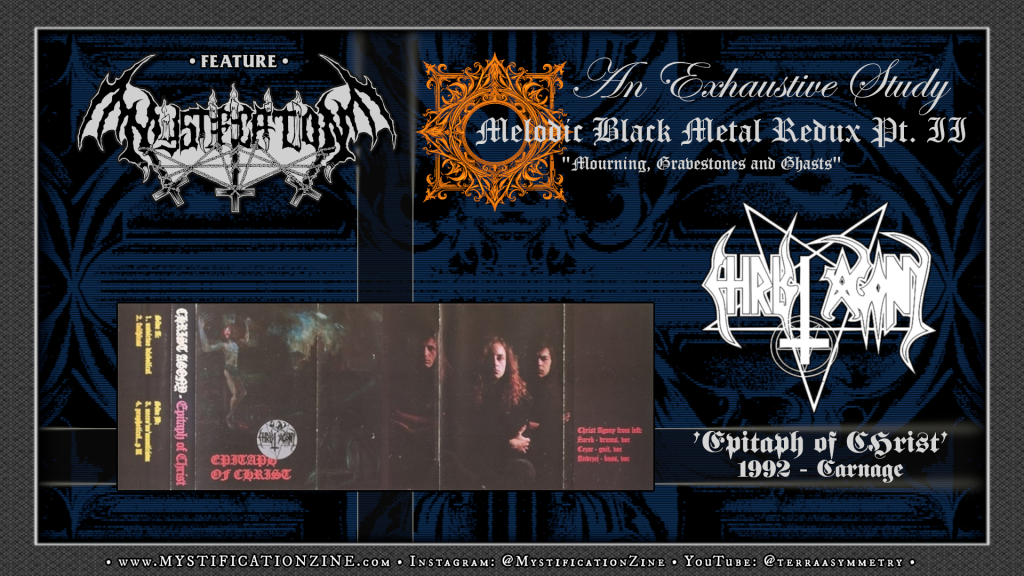
On this second demo tape from Polish melodic black/death mainstay Christ Agony we still find Hellhammer and Venom infused “black doom” metal pacing as a key component of their movement alongside some melodic developments which are erratic at best, nigh folkish beyond some slight ‘Gothic‘-era Paradise Lost movement in the introduction of the first song. Vocal experiments, heavy metal riffs, and a more pronounced directive from the bass guitarist all weirdly compliment the present yet artificial drum sound which features the tom samples you’ll find on thrash albums like ‘Schizophrenia‘ and ‘Pleasure to Kill‘. Needless to say this was still a formative experience from the band. Though one could accuse the early sound of the trio as similar to Samael‘s first couple of releases here we find something likely more interesting to fans of Necromantia for its tangent prone and arguably avant-garde, unpredictable movement. I’ve always appreciated the jammed, messy feeling of this tape because those shambling rhythms match up with vocal wrath and serious tone in a strange, arcane way which is difficult to replicate in terms of its musty adventure. I’m not sure I could classify this as an improvement upon the first demo in terms of coherent musicianship but it is a small step taken toward thier defining debut LP, and there is a lot to check out here by way of this strange ~28 minute tape.
More Info:
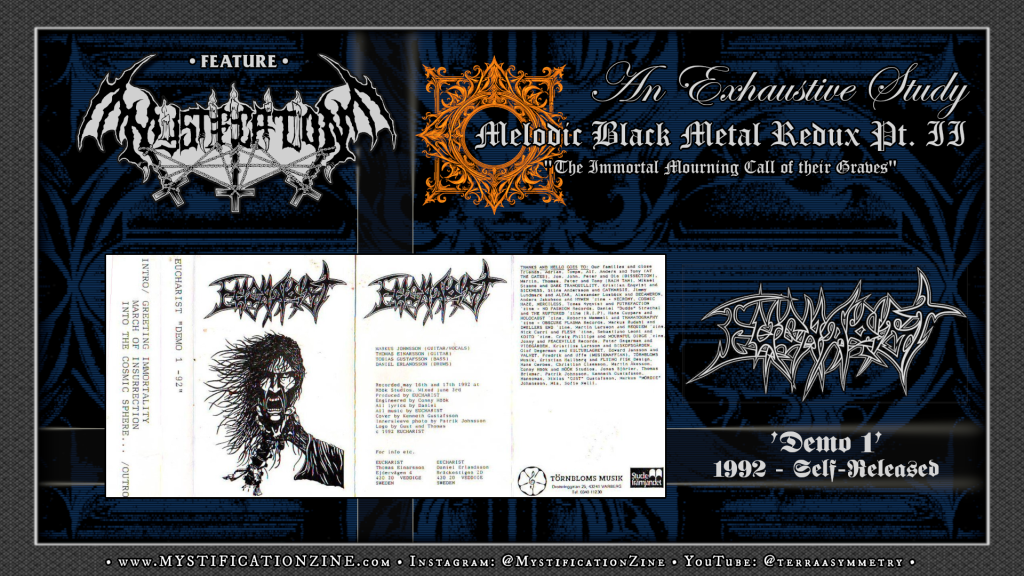
Instead of letting the first Dark Tranquillity 7″ (‘A Moonclad Reflection‘, 1992) communicate the still half-formed aesthetic and shapes of melodic death metal songwriting (as we’ll soon know them beyond 1993) I’d rather continue to focus on the more accomplished and volatile concoctions of Eucharist‘s 1991-1993 intensity as they’d built the lasting structure of Swedish melodic black/death metal just as well and their influence is evident before any lines were clearly drawn as we take a lens to composition and performance. First, the layered dramatism here isn’t limited to the guitar work as Markus Johnsson‘s range of expression on vocals is at once an intelligible rasp and a more chest-burst growl depending on the movement. Second, we find some parity with the sophistication available to ‘The Somberlain‘ demos in terms of completely formed signature pieces being prominently featured. At this heightened point of invention for many young groups fumbling their way toward genius it’d seem Eucharist were one of the bands putting in the work without losing sight of what death metal was doing at the time and in this sense it was easy for folks to see a record like ‘The Red in the Sky is Ours‘ in hindsight and figure this band’s work was built a step behind a band like At the Gates when in fact each band had been moving in their own respective directions. That said, you might have to squint hard to view this first demo as revelatory beyond what unique mechanics its songcraft promises. Again, we will be able to identify a handful of Swedish bands up through 1994 or so using some of these songs as raw template for the way forward.
More Info:
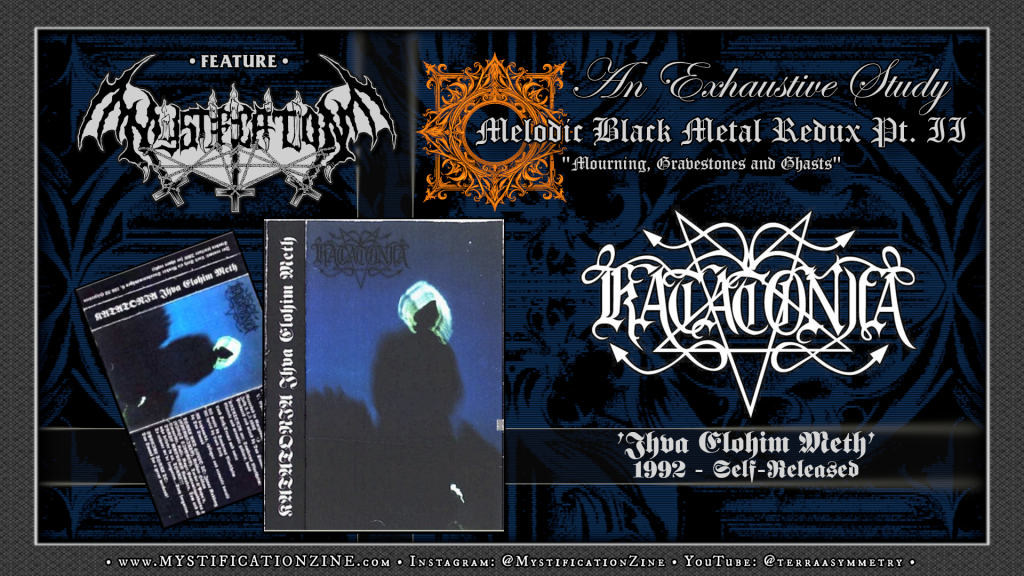
History has long disagreed with the sonic reflection the original duo of Katatonia saw in the mirror back in the early 90’s though that doesn’t mean they were ever off the mark in considering themselves a black metal band in spirit. Not only do we find them in corpse paint, brandishing farming tools as weapons, and exploring snow-flocked graveyards in early photographs but a notably depressive darkwave/gothic rock fueled touch, flowing melodic guitar work and a heady atmospheric voice helped these Stockholm-based folks identify as a black/doom metal band from the start. Of course in hindsight melodic death/doom and (by some definitions) depressive black metal foundations were heavily inspired by those early works; Developing their own ideas since 1987 but officially at work on thier own gig by 1991 Katatonia were certainly not the first to fuse gothic rock, doom metal, and such in with extreme metal (see: Monumentum‘s ‘Musaeum Hermetium‘ tape + many others…) but they were certainly the most profound songwriters within the (not always particularly self-aware) underground sects within early 90’s Sweden, writing miserably poetic longform pieces and featuring a very strong ally in Dan Swanö, an important figure for Swedish extreme metal early on and a celebrated producer, engineer and musician beyond those beginnings. This tape paired with their debut LP (‘Dance of December Souls‘, 1993) are among my all-time favorite works.
The main reason for including this tape is to begin growing psychic linkage to Paradise Lost‘s profound influence upon melodic metal in general, consideration for atmosphere and gothic metal by way of similar death/doom metal bands (My Dying Bride, Anathema, etc.) and for the sake of presenting an “unreal” outlier who’d introduced a variable of gothic rock and darwave to the Swedish melodic death and black metal sounds which often involved Poe-level gothic lyricism in broken English, use of keyboards, acoustic guitar breaks (which already existed per other Bathory influenced acts, mind you). Is it melodic? Yes. Is it black metal? At the time I’m not sure the distinction mattered beyond ad copy but as we consider all avenues for the melodic black metal zeitgeist we find atmosphere, aesthetic, romanticism, and overall sound design vitally important to consider per this tape. I’ve also included a link to their standalone follow up ‘Rehearsal ’92‘, a completely under appreciated set of songs which are perhaps more “black metal” than their official choices made when it came time to put stuff to tape, though they did re-record them in a 2022 retrospective box set (also included.)
More Info:
YouTube: https://www.youtube.com/watch?v=sAiSx6AQxi8
Rehearsal ’92: https://www.youtube.com/watch?v=Apj6lFto000
Re-recordings of Rehearsal ’92: https://www.youtube.com/watch?v=Akgmzirtahs
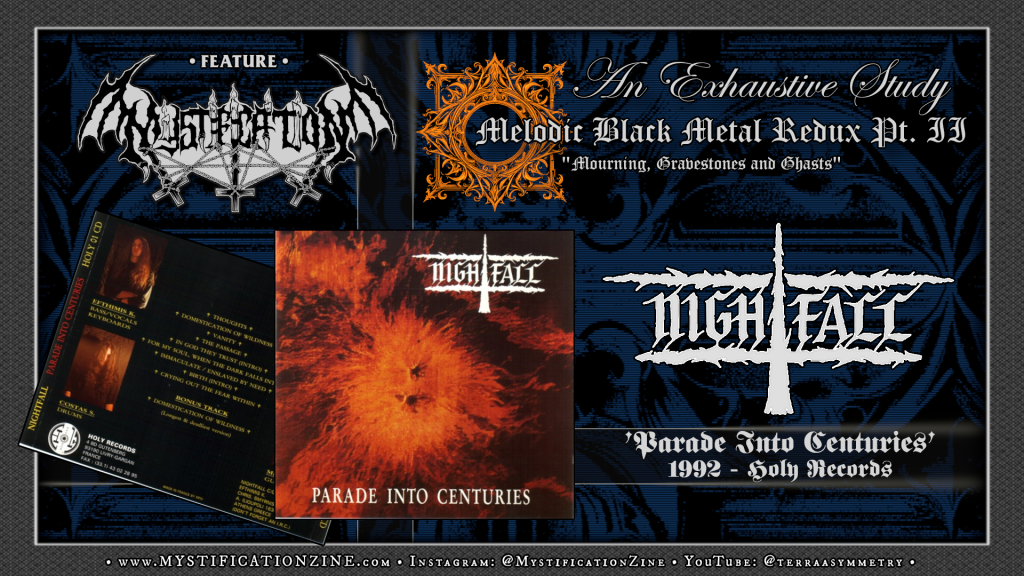
Early blackened gothic death metal? What could we consider this just as hasty but nicely developed follow-up to Athens, Greece-based group Nightfall‘s 1991 demo tape? Gothic metal inspired death-thrash? An early classic of Hellenic death metal? In fact there is no great way to sum the early sound of these folks as they point to the bravado of ‘Gothic‘ from Paradise Lost and their thrash and death metal beginnings as ingredients for this album which isn’t so wildly unrelated to similar breakthroughs Katatonia (and others) were having around the same time with what we’d eventually (briefly) call “dark metal.” In this case the black metal aspect of it was never a profound piece of the equation, though any fan of Nergal or nearby will appreciate the use of keyboards as a melodic device and fans of Necromantia should enjoy the noodled-at bass guitar work herein. The storming pace of their work and its adjacency to the nearby melodic evolution of Rotting Christ earns a spot somewhere between the gothic romanticism and punishing death metal of (early) Septicflesh and the not-so separate evolution of Greek black metal. Why is this important to melodic black metal? We should do our best to avoid boxing-in notions of melody in black metal to severe, or, cut-and-dry definitions since we’ve avoided some pure black metal bands which use melody thus far, escaping the sense that well… most rock music inherently has melody. The important thing is to identify traits as they arrive and note when these ideas become accepted portions of the greater vernacular. The language of melodic black metal found its way into Nightfall‘s eclectic work but we are still a long way from finding that defining LP which’d given the globe notice of the standard, notion and shape of the sub-genre.
Also, for the sake of trivia this was the first release from French label Holy Records which was owned by Philippe Courtois of progressive/melodic death group Misanthrope who I believe was in marketing school (?) with some other partners when they decided to start a label and sign bands they were impressed with.
More Info:
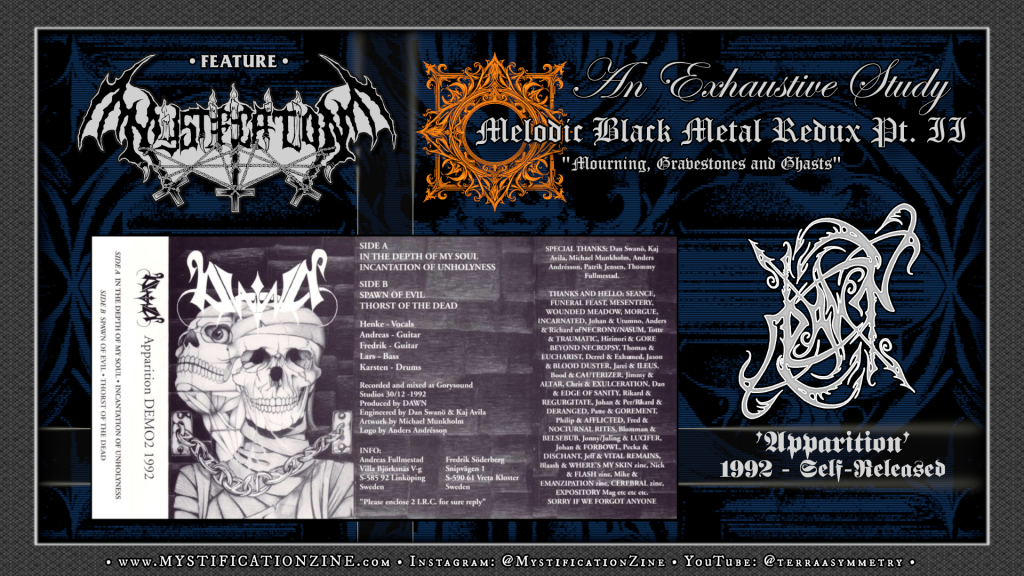
We return to Dan Swanö‘s Gorysound Studios for this very late in the year second demo tape from Dawn who’d held onto their death metal vocals, brutally aggressive riffcraft and frantic pacing for this mind-melting set of four songs, all of them built in the best traditions of Swedish death metal. We find the band making their leap in terms of perfectionist traits, seamless compositions which allow little breathing room despite their broad strokes and in this sense their work was nearly on par with the focus of At the Gates‘ debut that same year (it’d released a month before) while incorporating some semi-melodic movements (compare “In the Depth of My Soul” directly with Eucharist‘s “March of Insurrection”) amidst some additional shaping by way of light use of keyboards on Side B. It was something a bit different than the Deicide and Slayer-amped kill-streaks forming in the hands of groups like Seance and Necrophobic at the time, but not all that far outside the box just yet. We cannot yet fully see the melodic black/death metal side of the band fully emerging but we will get very different versions of some of these same songs on their next tape and eventually their 1994 debut LP, another all-time favorite release of mine.
More Info:
We walk away from 1992 CE having taken three steps forward and two steps back as our notion of melodic black metal’s origins begins to tread water in some respects. Keep in mind it wasn’t just black metal flooding the underground with interest, bands like Entombed and Morbid Angel were enjoying increasingly massive notoriety, among others and this had many folks unable to predict the future winds of change. All the while melodic death metal threatens to burst at the seams within a small series of demo-level breakthroughs, nearing its earliest point of sophistication with a handful of signature pieces in tentative form. Of course Dissection and Eucharist are rightfully the focal point of the black/death metal equation, given outright melody meshing with brutal mechanics serving a point of fusion, but there is plenty else brewing alongside that obvious standout wherein we also find a new breed of black, death, and doom metal artists aiming… or, stumbling upon melodies which are nearing a point of memorable value in relation to our study. This stage is probably most interesting to the death metal demo hound, folks who are likely obsessed with interesting patternation or technique surrounding the riff (count me among them), but as we ride into the multi-part exploration of 1993 next time you’ll start to see the inspiration coming from these ideas spreading to the United States and South American black/death metal scenes alongside a much heavier focus on atmosphere within black metal. We will still be locked in the demo tape dungeon for a few more weeks but also discovering a series of roughly ~6-8 important full-lengths that’d soon release and help define melodic death metal, melodic black/death metal, and melodic black metal as separate pursuits going forward.

Help Support Grizzly Butts’ goals with a donation:
Please consider donating directly to site costs and project funding using PayPal.
$1.00
Make a one-time donation
Make a monthly donation
Make a yearly donation
Choose an amount
Or enter a custom amount
Your contribution is appreciated.
Your contribution is appreciated.
Your contribution is appreciated.
DonateDonate monthlyDonate yearly
